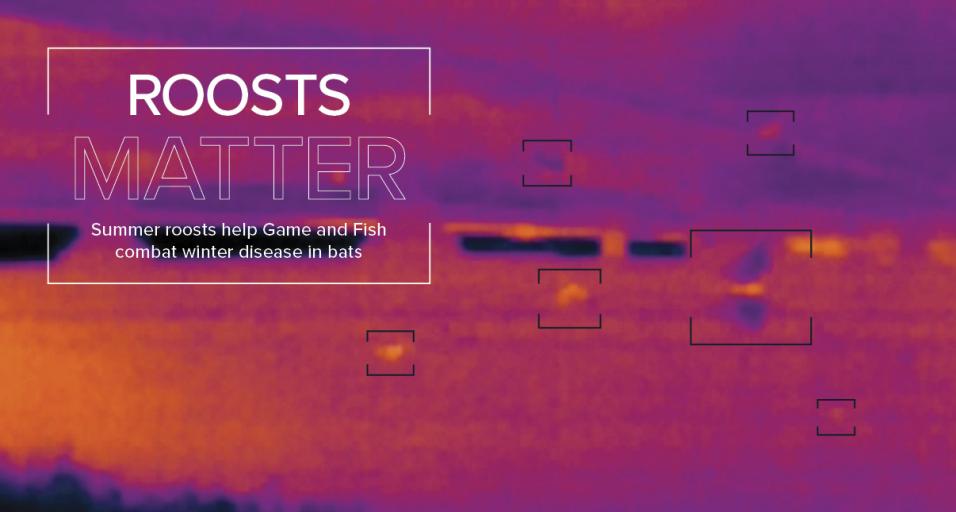Imagine sitting by a warm campfire on a starlit evening. As you listen to stories shared by the firelight and roast marshmallows, you hear an obnoxious, high-pitched buzzing in your ear. Hungry swarms of mosquitoes have arrived looking for their own late-night snack. What began as a tranquil evening has turned into a miniature battle between you and these blood-sucking bugs.
Suddenly, a dark shadow swoops in and out of the firelight. As you look overhead, for a split second you wonder what kind of bird is flying in the darkness. But it is no bird. Another of these winged wonders comes flashing in and out of view: a bat. These nocturnal creatures often get a bad reputation that comes from the stuff of campfire legends. The bats aren’t there to bother you and your fellow campers. These small, flying mammals have arrived as air support to your mosquito battle. They have come for a feast of the insect variety, and they’ll eat them by the thousands.
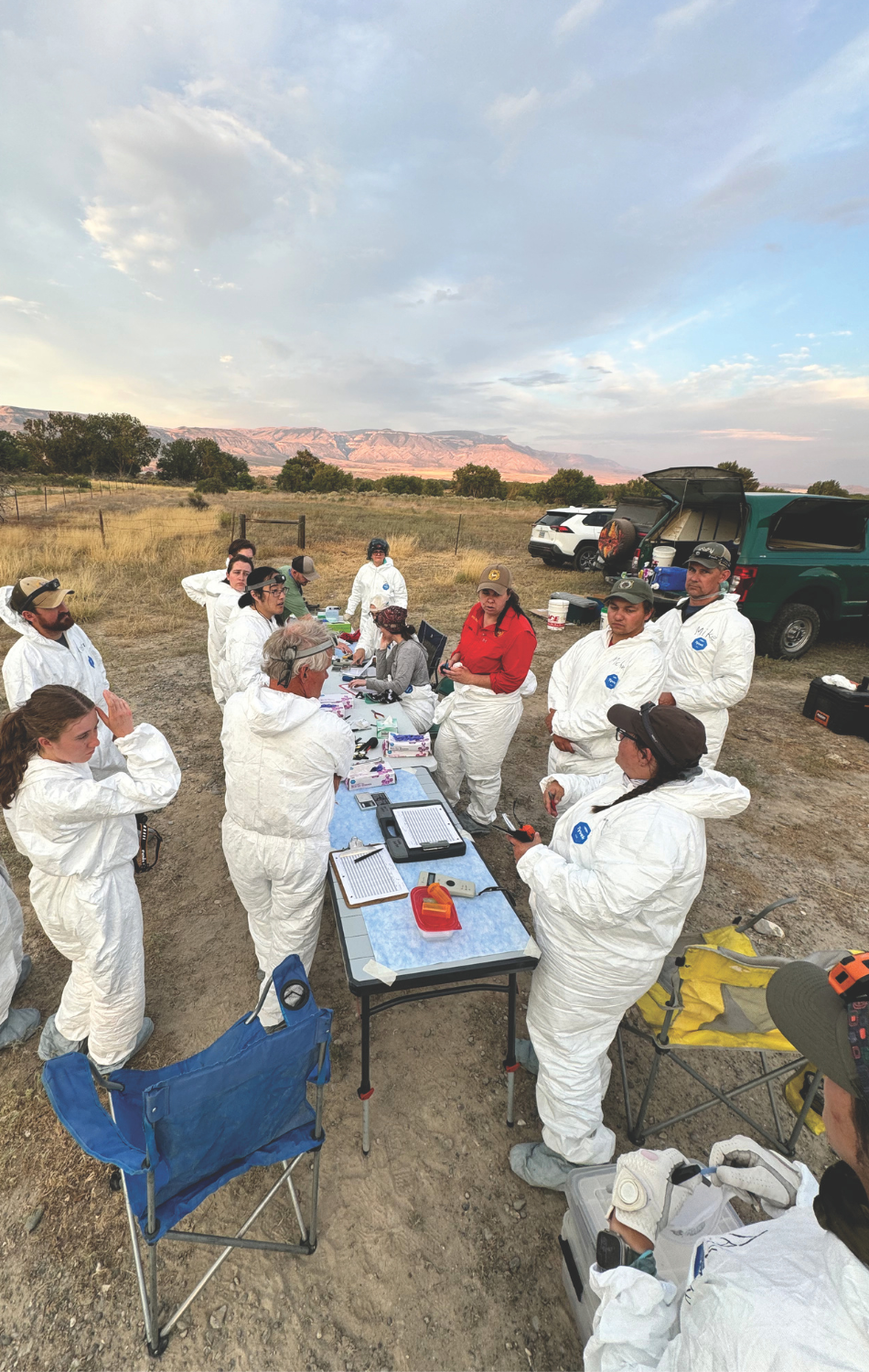
Collaborators from Game and Fish, United States Geological Survey, Colorado State University, U.S. Fish and Wildlife Service, University of Wyoming, Montana Fish, Wildlife and Parks, Northwest College and the Draper Natural History Museum prepare to capture bats for the USGS white-nose syndrome trial. (Photo by Britney Force/WGFD)
Laura Beard has made a career of studying these miniature mammals. Beard is the bat biologist for the nongame section of the Wyoming Game and Fish Department. She and her crew travel across the state to monitor bat populations and the progress of a fungus that threatens them.
They carry specialized acoustic recording equipment to document bat sonar on the landscape, infrared camera technology to observe bats exiting roosts, capture equipment to help biologists take a closer look and tools like scales and calipers to take measurements of bats once they have them in hand. It is a lot of effort for such a tiny mammal. Beard and her team are responsible for monitoring bat populations to understand the impacts of conservation challenges on bats.
R&R: ROOSTS AND RESEARCH
All Wyoming bats are insectivores, which means their diet consists entirely of insects. These bats play a significant role in helping to control insects that can be pests for crops or carry diseases. For example, little brown bats commonly found in Wyoming, can eat hundreds of insects per hour, which for some little brown bats can be 100 percent of their body weight in one night.
Little brown bats and other similar species are under attack by a disease that has killed millions of bats in the eastern U.S. White-nose syndrome is caused by a fungus that attacks bats during hibernation, draining fat reserves and causing death. In the face of this threat, biologists like Beard are conducting monitoring and research studies to help conserve bat species across the country. However, these animals can be challenging to study in the West, as they don’t gather in as large numbers in the winter like eastern populations once did. Their small size and nocturnal activity create research and monitoring challenges, making it difficult to get accurate population sizes and document mortalities. However, there are some solutions to studying these species, and one strategy requires the use of summer roosts.
A roost is an area where animals like bats or birds congregate to rest. Bats use roosts each day to rest, but winter and summer roosts are the most important, as they support critical events in the bat’s year. In the winter, many species of bats use a roost called a hibernaculum. As the name suggests, they use this type of roost for hibernation, which allows them to survive the long cold season without bugs to eat. In the eastern U.S., large numbers of bats gather in underground cavernous areas such as caves or mines. Biologists in the western U.S. cannot rely on these types of roosts because western bats rarely use this type of hibernacula.
However, there is a second roost called a maternity roost. Biologists rely on this type of roost in the summer to monitor western bats. Maternity roosts are warm areas found in buildings, under tree bark, in rock crevices or within a hollow tree where pregnant female bats give birth and nurse their young. Knowing where bat roosts are located helps biologists understand population trends of western bat species and track the spread of white-nose syndrome.
Knowing how animals behave, reproduce and live on the landscape is crucial to monitoring and understanding how to support a healthy population. Researchers rely on maternity roosts to help provide accurate population information. According to the Western Bat Working Group, challenges such as climate change, habitat loss, persecution, wind energy development and white-nose syndrome all impact bat conservation.
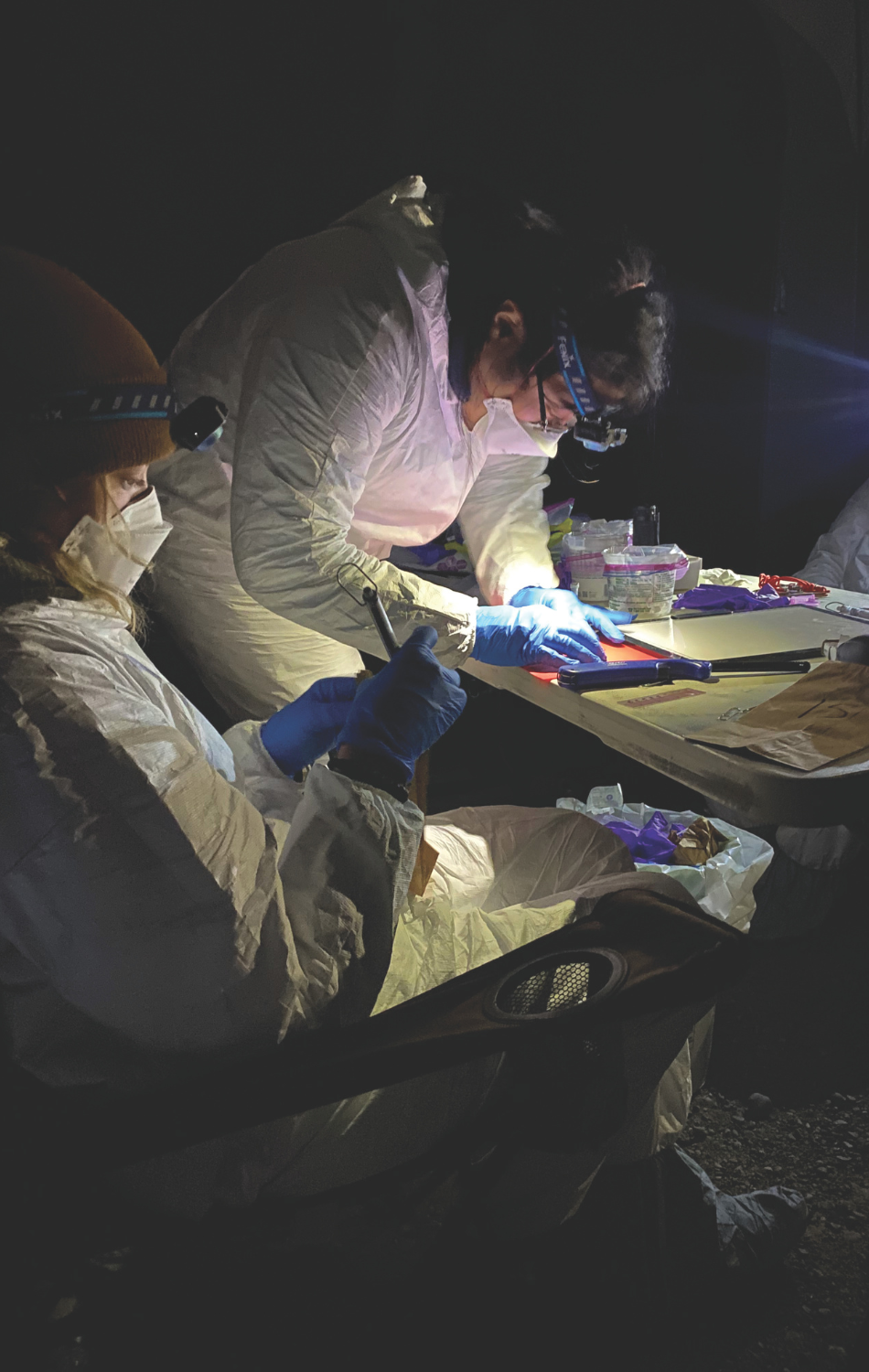
Bat technicians Britney Force and Adam Nash process bats when sampling for the fungus that causes white-nose syndrome. (Photo by Julia Yearout/WGFD)
MONITORING METHODS
Game and Fish uses several types of monitoring to understand bat distribution, populations and trends in the state.
These include hibernaculum counts, maternity roost counts, recording bat sounds and bat captures. Repeated roost surveys at known maternity roosts are vital to population monitoring and can help biologists address the conservation needs of bats in Wyoming and the Rocky Mountain West. Knowing the locations of established maternity roosts helps with the collection and analysis of population data.
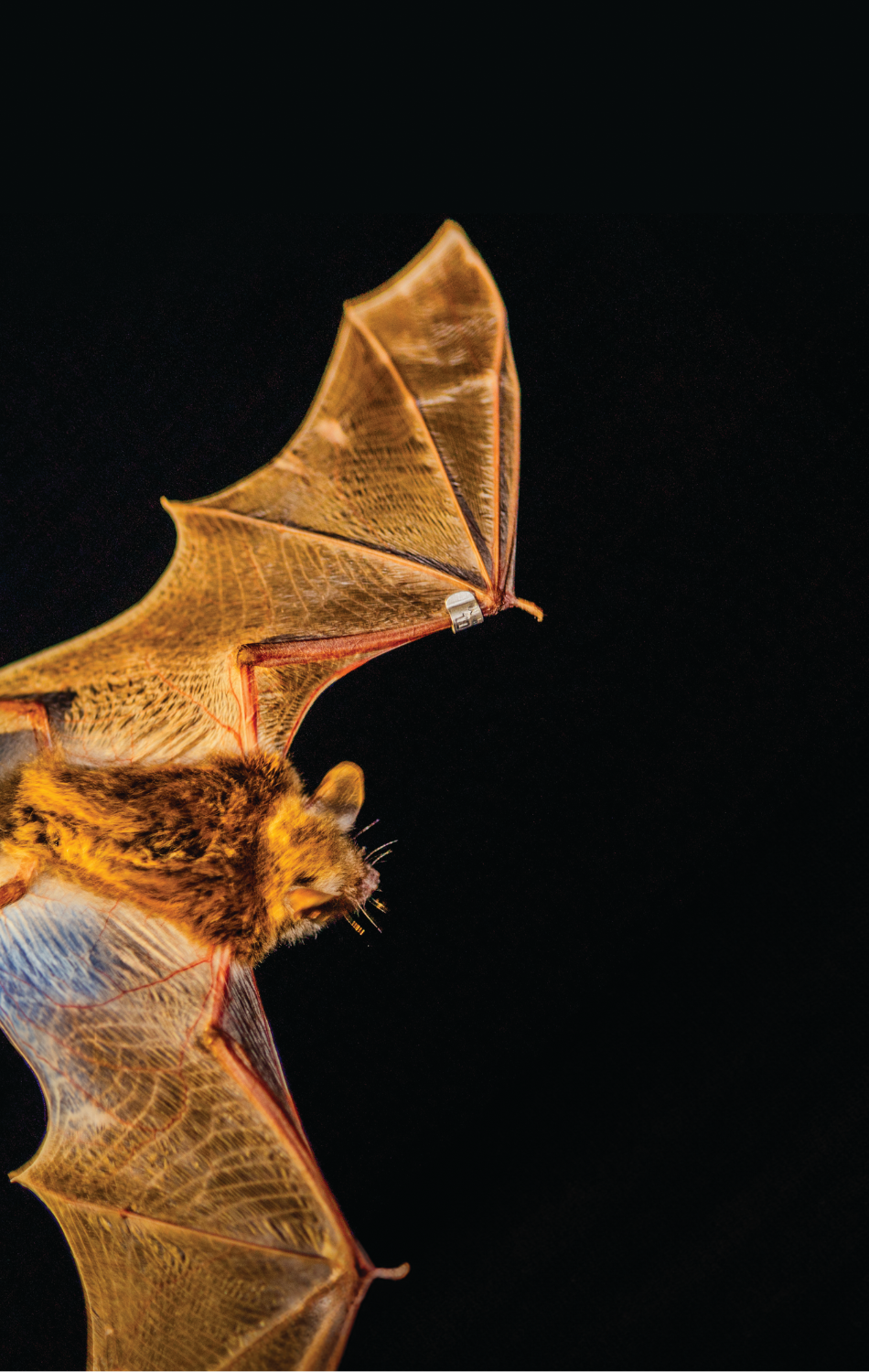
A little brown bat sports a band on its forearm. As part of a vaccine trial, bats are given a vaccine or a placebo and marked with a special microchip and band. (Photo by Emalee Smith/WGFD)
In addition to population counts across Wyoming, getting a pulse on the impacts of white-nose syndrome is key for bat conservation.
“White-nose syndrome is a disease caused by an introduced fungal pathogen called Pseudogymnoascus destructans or Pd, that attacks bats when their immune systems are depressed during hibernation,” Beard said.
Sometimes Pd looks like white fuzz on a bat's face, and that is how the disease got its name. It attacks the bare skin of bats while they hibernate in cool, damp places. As the fungus grows into their skin, bats become more active than usual during hibernation, which causes them to burn through fat stores prematurely and eventually kills them. Some bat species are more affected by the fungus than others. White-nose syndrome affects many small-bodied, hibernating species like the little brown bat with very high mortality rates, while other species are less affected. Some species of bat, such as Townsend’s big-eared bat, can hibernate with the fungus on them without any apparent symptoms of the disease developing. White-nose syndrome has been devastating to many bat populations in the eastern U.S.
For Beard and her crew at Game and Fish and partners at the University of Wyoming, the Wyoming Natural Diversity Database and the United States Geological Survey, conducting surveillance on the spread of the fungus Pd and white-nose syndrome is crucial to bat conservation in Wyoming.
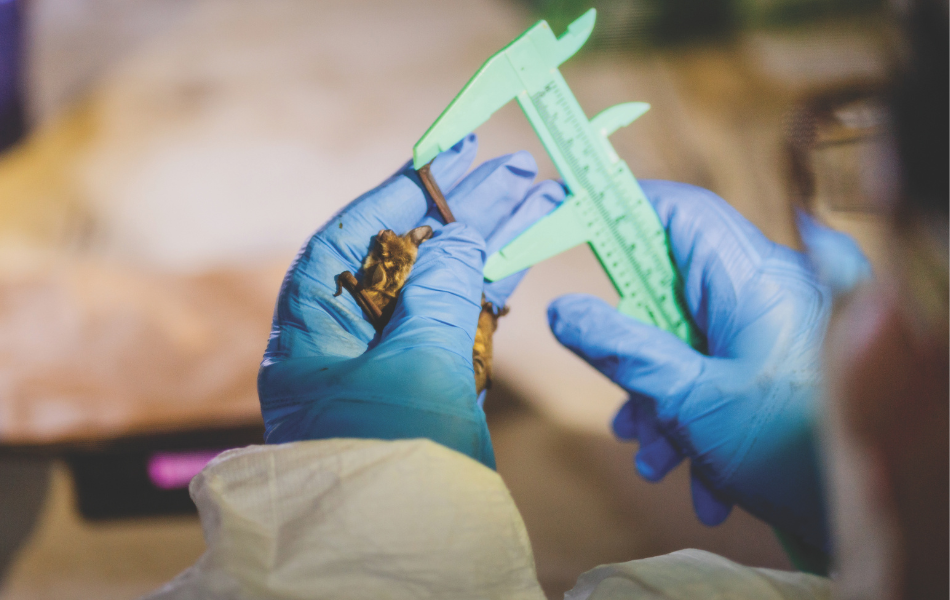
A technician measures a bat as part of ongoing bat research. (Photo by Emalee Smith/WGFD)
White-nose syndrome was first identified in the eastern U.S. as early as 2006. Pd was detected in southeast Wyoming in 2018. White-nose syndrome was detected in bats at Devils Tower National Monument in 2021. So far, eight species of bat found in Wyoming have proven to be vulnerable to white-nose syndrome, including little brown bats and other similar species. Six additional species have been found with the fungus but no symptoms of the disease.
To check for Pd, biologists and technicians swab bats or bat carcasses shortly after the bats leave hibernacula and collect samples from the floor of winter caves. Since species affected by white-nose syndrome do not hibernate in large, accessible roosts in Wyoming, biologists swab them in the spring after they emerge from hibernation, either while foraging on the landscape or once they return to maternity roosts. This is why knowing about maternity roost locations can help biologists fight white-nose syndrome. Collecting bat feces from roost sites is another sampling method. Collecting samples directly from bats in the spring is best for early detection of the fungus.
“In addition to these targeted surveillance efforts, Game and Fish coordinates with the USGS’s National Wildlife Health Center and the University of Wyoming to test bats after they have been submitted for rabies testing. All bats submitted for Pd testing through this method must first test negative for rabies,” Beard said.
Known roost locations can help biologists and researchers fight against white-nose syndrome. Maternity roosts may help advance a vaccine for white-nose syndrome and monitor bat populations. A vaccine for white-nose syndrome has been in development and has been shown to be safe in captive little brown bats.
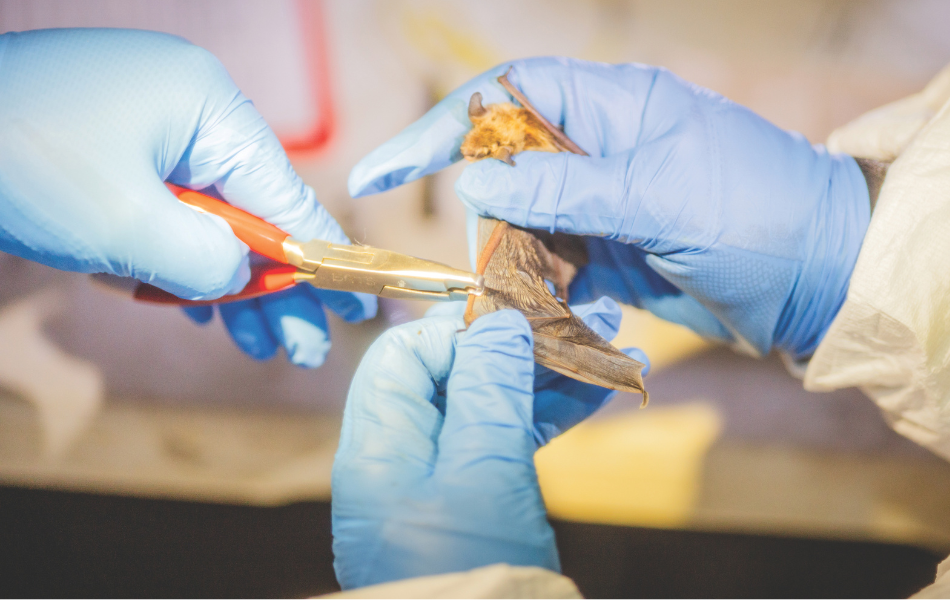
Biologists place a band on a bat's forearm as part of a vaccine trial. (Photo by Emalee Smith/WGFD)
A USGS vaccine trial began in 2023 at two maternity roosts in Wyoming for little brown bats. Biologists captured bats with mist nets at these locations and marked them with a special microchip called a PIT tag. They also affixed a band to each bat’s forearm. The bats were given either a placebo or the vaccine. Researchers from the National Wildlife Health Center will compare survival between bats given the vaccine and the placebo to find out how much the vaccine helps them survive white-nose syndrome over the following winter. This vaccine trial continues through 2024. In addition to Wyoming, the vaccine is being trialed at other recently infected maternity roosts in other states in the Rocky Mountain West. This crucial research and monitoring would not be possible if we did not know the locations for maternity roosts in Wyoming.
“We find out about maternity roosts from landowners reaching out across the state,” Beard said. “We appreciate landowners for their willingness and partnership in conserving bats. We find most of our roosts based on notifications trickling to us either directly from the landowner or the landowner contacting a warden or regional Game and Fish biologist.”
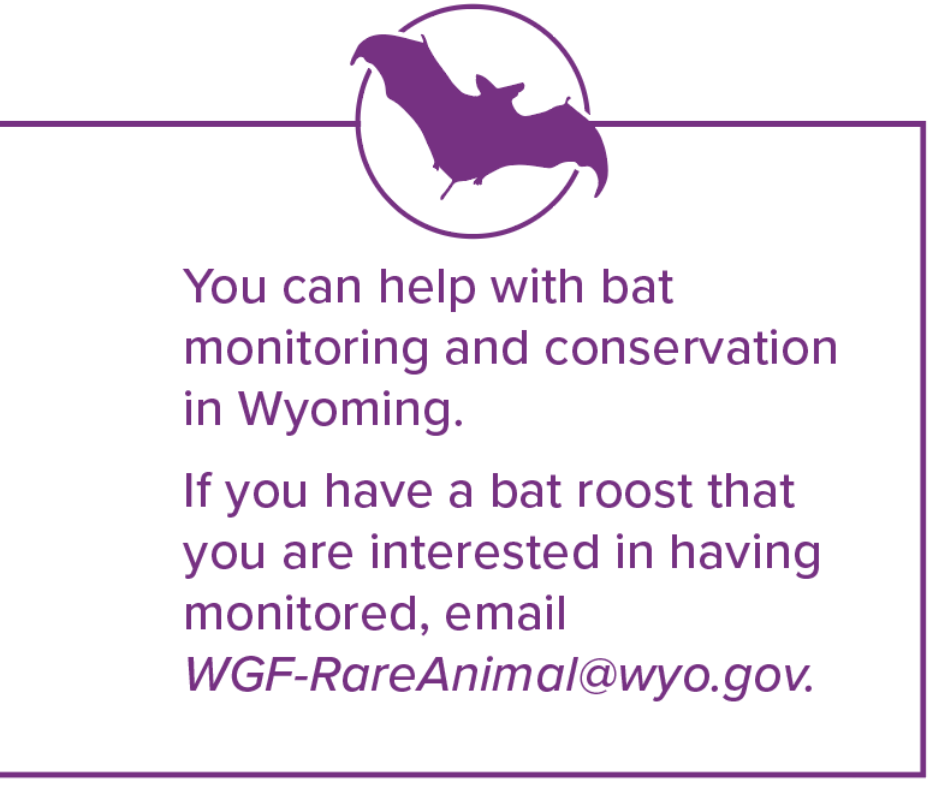
Some of the landowners are willing to keep maternity roosts on their property and allow for roost monitoring to occur.
“We are so grateful to the landowners for allowing Game and Fish and other research partners to access and survey the maternity roosts,” Beard added. “I am immensely proud of this state, the landowners and the public for stepping up to offer this information on suspected and known bat maternity roosts. You can tell the people of Wyoming care about bat conservation and understand how these small mammals play a vital role in the ecosystem.”
— Katie Simpson is the Hunter Education Coordinator for the Wyoming Game and Fish Department. Laura Beard, Game and Fish bat biologist, contributed to this article.

